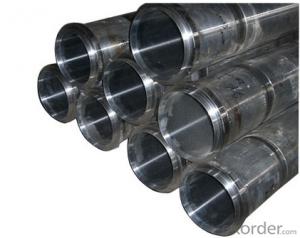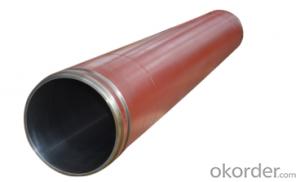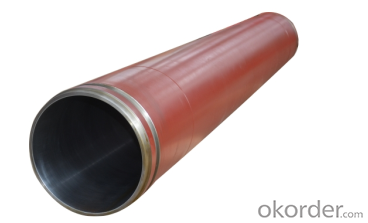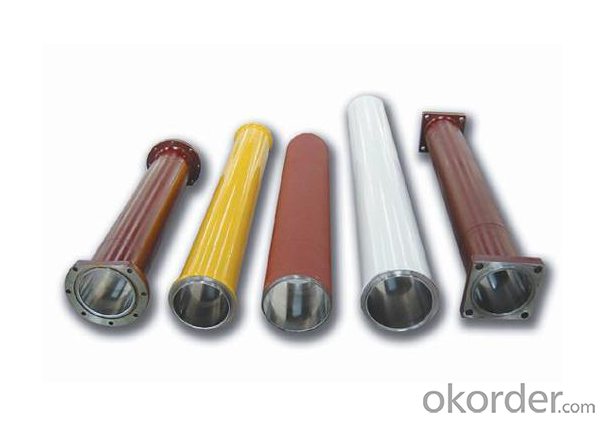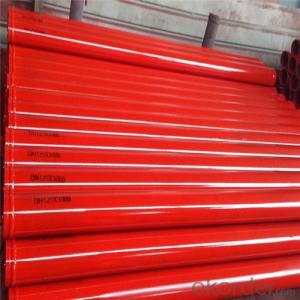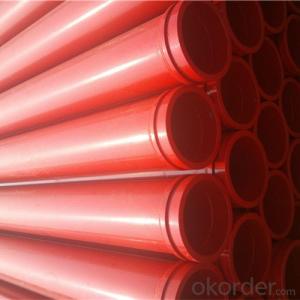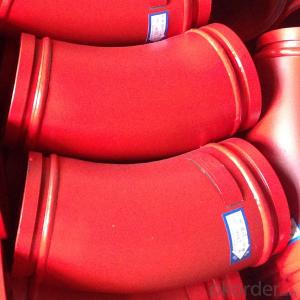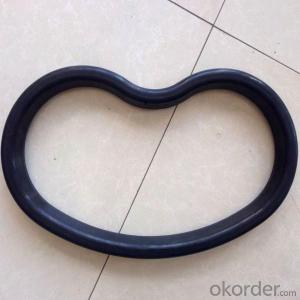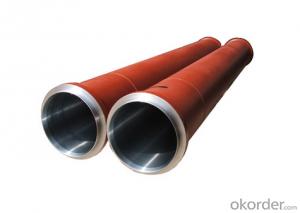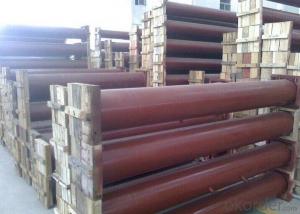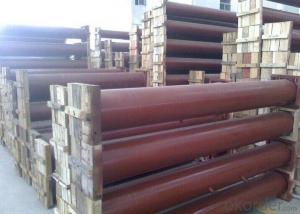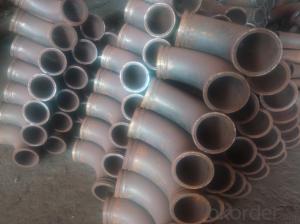PUMPING CYLINDER(ZOOMLION) I.D.:DN200 CR. THICKNESS :0.25MM-0.3MM LENGTH:1787MM
- Loading Port:
- Shanghai
- Payment Terms:
- TT OR LC
- Min Order Qty:
- 2 pc
- Supply Capability:
- 1000 pc/month
OKorder Service Pledge
OKorder Financial Service
You Might Also Like
Product Description:
The Concrete Pump Delivery Cylinder DN200*1787 normally made by steel material No. C45. according to customer’s requests, and also package in bundles or nude packing directly put into container.
Scope of Application of the Cylinders
The Pump Delivery Cylinder DN200*1787 is a Cylinder pumping for combined use with other concrete pumps parts in concrete pumping operations. It can be widely used in the construction of various types of concrete structures like industrial and civil buildings, bridges, roads, and other types of infrastructure.
This Cylinder Cylinder DN200*1787 can only be used in concrete pump construction operations, but not in any other operations, like dragging, moving, or hoisting heavy articles or personnel. The pipe is also not allowed to be used in any location where any combustible or explosive material exists or a cave-in may occur.
Specifications:
Concrete Pump Delivery Cylinder DN200*1787
1. Capacity: 60,000~80,000cbm
2. Size: DN180, DN200, DN230.DN250
3. Material: C45
4. quenching and tempering to improve the hardness to HB241-280
5. inner wall chrome thickness is 0.25-0.30mm, hardness HV820-900.
6. Brand: SCHWING, PM, SANY, KYOKUTO, CIFA
7. Capacity: 60,000~80,000cbm
Product Advantages:
OKorder's Cylinders DN200*1787 Channels are durable, strong, and safety.
Main Product Features:
· Premium quality
· Prompt delivery & seaworthy packing (10-20 days)
Reliable performance
Easy to weld
High safety.
· Professional Service
· Competitive pricing
Measuring of wall thickness from the outside
Low purchase cost
FAQ:
Q1: How long about delivery time about DN200*1787 ?
A1: Normally we keep the raw materials for old customers and sometime we also keep stock products to make sure delivery time in any emergency cases.
Q2: How do we guarantee the quality of our Cylinders DN200*1787?
A2: We have established an advanced quality management system which conducts strict quality tests at every step, from raw materials to the final product. At the same time, we provide extensive follow-up service assurances as required.
Q3: How soon can we receive the product after purchase?
A3: Within three days of placing an order, we will book the vessel for goods. The specific shipping date is dependent upon international and government factors, but is typically10 to 30 workdays.
Q4: If we can produce some Cylinders DN200*1787 according to customers request?
A4: Yes, we can produce Cylinders DN200*1787 according to the difference country situations to make it suitable to the market and customers. We have very professional technical team to make the design.
Q5: How to make a quick resolution for after service?
A5: OKorder and our manufacture both have overseas branches all-around of world, If needed,
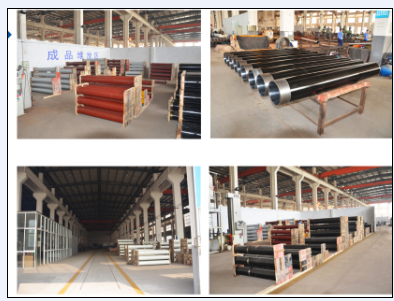
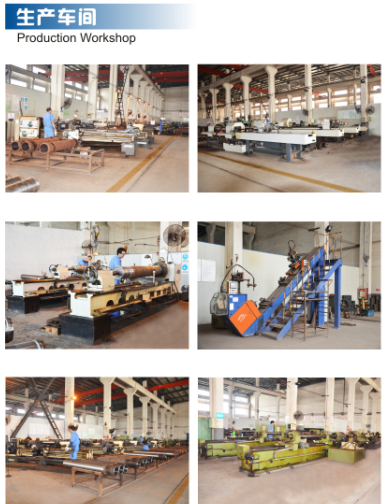
- Q: What are the consequences of using substandard concrete pump spare parts?
- Using substandard concrete pump spare parts can have several consequences. Firstly, substandard parts may not fit properly or be of the same quality as the original parts. This can lead to a decrease in the overall performance and efficiency of the concrete pump. The pump may not be able to deliver the required amount of concrete or may experience frequent breakdowns, resulting in project delays and increased costs. Secondly, substandard parts may have a shorter lifespan compared to genuine parts. This means that they may wear out or break down sooner, requiring more frequent replacements. This not only adds to the maintenance costs but also increases the risk of unexpected equipment failures during operation, which can be dangerous to the workers and potentially cause accidents. Furthermore, using substandard parts can compromise the safety of the concrete pump. Genuine parts are designed and manufactured to meet strict quality standards and ensure the proper functioning of the equipment. Substandard parts, on the other hand, may not undergo the same rigorous testing and quality control measures, making them less reliable and potentially more prone to failure. This can pose a serious risk to the operators and other personnel working in the vicinity of the concrete pump. Additionally, using substandard parts can also void any warranties or guarantees provided by the manufacturer. Manufacturers typically offer warranties on their products to ensure customer satisfaction and provide support in case of any issues. However, if substandard parts are used, the manufacturer may refuse to honor the warranty, leaving the owner responsible for any repairs or replacements needed. In summary, using substandard concrete pump spare parts can result in decreased performance, increased maintenance costs, higher risks of accidents, and the voiding of warranties. It is crucial to always use genuine parts that are specifically designed for the concrete pump to ensure its optimal performance, longevity, and safety.
- Q: Can I get spare parts for both concrete pumps with and without boom stabilizers?
- Yes, spare parts are available for both concrete pumps with and without boom stabilizers. When it comes to concrete pumps, manufacturers typically offer a wide range of spare parts to ensure the longevity and smooth operation of their equipment. These spare parts can include hydraulic components, valves, hoses, seals, wear plates, pipes, and many others. Whether your concrete pump has a boom stabilizer or not, you can easily find and purchase spare parts from the manufacturer or authorized dealers. Additionally, there are also aftermarket suppliers who specialize in providing spare parts for various concrete pump models. So, regardless of the specific features of your concrete pump, you can rest assured that spare parts are readily available to keep your equipment running smoothly.
- Q: What are the different types of concrete pump hydraulic pumps?
- Concrete pumps commonly utilize a variety of hydraulic pumps. Here are several types: 1. Gear pumps, which are widely employed in concrete pumps, consist of meshing gears that propel hydraulic fluid from the inlet to the outlet. Gear pumps are renowned for their simplicity, durability, and reliability. 2. Piston pumps, another popular choice in concrete pumps, employ reciprocating pistons to move hydraulic fluid. These pumps are known for their ability to handle heavy-duty applications and generate high pressure. 3. Vane pumps are often used in smaller concrete pumps or as auxiliary pumps in larger ones. They rely on rotating vanes within a housing to move the hydraulic fluid. Vane pumps are prized for their compact size and efficiency. 4. High-pressure concrete pumps commonly employ radial piston pumps. These pumps have multiple pistons arranged radially around a central shaft. The pistons' alternating motion creates the pumping action. Radial piston pumps are esteemed for their power and efficiency. 5. Large concrete pumps frequently utilize axial piston pumps. These pumps feature multiple pistons arranged in a circular pattern around a central shaft. The pistons move linearly to generate the pumping action. Axial piston pumps excel in high flow rates and pressure capabilities. Ultimately, the choice of hydraulic pump for a concrete pump depends on factors such as pump size, desired pressure and flow rate, and specific application requirements.
- Q: Are there any specific warranty options available for concrete pump spare parts?
- Yes, there are specific warranty options available for concrete pump spare parts. Many manufacturers and suppliers offer warranties on their products to provide customers with peace of mind and assurance of quality. The specific warranty options may vary depending on the manufacturer or supplier, but they generally cover defects in materials or workmanship. It is recommended to carefully review the warranty terms and conditions before purchasing concrete pump spare parts to understand what is covered and for how long. Some warranties may provide a limited duration of coverage, while others may offer extended warranties for an additional cost. Additionally, it is important to follow the recommended maintenance and usage guidelines to ensure the warranty remains valid. In case of any issues or concerns with the spare parts during the warranty period, customers can typically contact the manufacturer or supplier for assistance.
- Q: How do I properly maintain and replace hydraulic filters in concrete pump spare parts?
- Proper maintenance and replacement of hydraulic filters in concrete pump spare parts is crucial to ensure the longevity and efficiency of your equipment. Here are some steps to follow: 1. Understand the manufacturer's recommendations: Start by familiarizing yourself with the manufacturer's guidelines for maintaining and replacing hydraulic filters. These instructions may vary depending on the specific pump model and filter type. 2. Regular inspection: Regularly inspect your hydraulic filters for any signs of damage, clogging, or excessive wear. Look for dirt, debris, or other contaminants that may hinder the filter's performance. If you notice any issues, it is important to address them promptly. 3. Follow a maintenance schedule: Implement a regular maintenance schedule for your hydraulic filters. This schedule should include regular filter inspections, cleaning, and replacement intervals. Adhering to a schedule will help prevent unexpected breakdowns and keep your concrete pump running smoothly. 4. Cleaning the filters: If your hydraulic filters are designed to be cleaned and reused, make sure to follow the proper cleaning procedure. This typically involves removing the filter, washing it with an appropriate cleaning solution, and allowing it to dry thoroughly before reinstallation. Be cautious not to damage the filter during the cleaning process. 5. Replacement: Over time, hydraulic filters will become less effective at filtering out contaminants. It is important to replace them according to the manufacturer's recommended intervals or sooner if they appear excessively dirty or damaged. Always use genuine spare parts to ensure compatibility and optimal performance. 6. Proper installation: When replacing hydraulic filters, ensure that they are installed correctly and securely. Pay attention to any seals or gaskets that may need to be replaced as well. Improper installation can lead to leaks or reduced filtration efficiency. 7. Monitor performance: After replacing the hydraulic filters, monitor the pump's performance closely. Pay attention to any changes in pressure, flow rate, or unusual noises. If you observe any abnormalities, it may indicate a problem with the filter or other components, and further investigation may be necessary. By following these steps, you can properly maintain and replace hydraulic filters in your concrete pump spare parts, ensuring optimal performance and prolonging the lifespan of your equipment.
- Q: How can one determine the correct voltage and current rating for electrical components in concrete pump spare parts?
- To determine the correct voltage and current rating for electrical components in concrete pump spare parts, several factors need to be considered. Firstly, it is essential to consult the manufacturer's specifications and documentation for the concrete pump and its spare parts. These documents usually provide detailed information about the voltage and current requirements for each electrical component. Paying close attention to these guidelines ensures that the components are operated within their designed parameters. Secondly, it is crucial to understand the electrical system and its requirements. This involves analyzing the power supply available at the site where the concrete pump will be used. Factors such as the voltage level (e.g., 110V, 220V, 440V) and frequency (e.g., 50Hz, 60Hz) of the electrical supply need to be taken into account. Additionally, the maximum current capacity of the electrical system must be considered to prevent overload situations. Furthermore, it is advisable to assess the specific application and operating conditions of the concrete pump. Different components may have varying voltage and current requirements depending on their function and the environment in which they are used. For instance, components installed in outdoor areas may require higher voltage ratings to withstand harsh weather conditions. Lastly, seeking professional assistance from qualified electricians or engineers is highly recommended. They possess the expertise and knowledge to accurately determine the voltage and current ratings for electrical components in concrete pump spare parts. Their experience allows them to consider various factors such as safety regulations, compatibility with the existing electrical system, and any specific requirements of the concrete pump manufacturer. By taking into account the manufacturer's specifications, understanding the electrical system, considering the application and operating conditions, and seeking professional advice, one can effectively determine the correct voltage and current rating for electrical components in concrete pump spare parts.
- Q: What is the function of a concrete pump water pump?
- The function of a concrete pump water pump is to supply water to the concrete pump system, aiding in the smooth and efficient operation of the equipment.
- Q: Can I get spare parts for concrete pump wear plates and cutting rings?
- Yes, you can definitely get spare parts for concrete pump wear plates and cutting rings. These parts are essential for the smooth operation and performance of a concrete pump. Many manufacturers and suppliers specialize in providing spare parts for concrete pumps, including wear plates and cutting rings. You can contact these suppliers or manufacturers directly to inquire about the availability and pricing of these spare parts. Additionally, there are also online platforms and marketplaces where you can find a wide range of spare parts for various concrete pump models. It is always recommended to ensure that you purchase genuine and high-quality spare parts to guarantee the longevity and efficiency of your concrete pump.
- Q: How often should hopper grate pins be inspected or replaced in a concrete pump?
- Hopper grate pins in a concrete pump should be inspected regularly to ensure proper functioning and prevent any potential issues. As a general guideline, it is recommended to inspect hopper grate pins at least once a month or after every 200 hours of operation, whichever comes first. However, the frequency of inspection may vary depending on the specific conditions and usage of the concrete pump. During the inspection, it is important to check for any signs of wear, damage, or deformation in the hopper grate pins. If any issues are identified, they should be promptly addressed to avoid further damage and ensure safe and efficient operation of the concrete pump. The replacement of hopper grate pins should be done as soon as they show significant signs of wear or damage that could compromise their functionality. It is essential to follow the manufacturer's guidelines and recommendations when replacing hopper grate pins, as they may vary depending on the specific model and design of the concrete pump. Regular inspections and timely replacements of hopper grate pins contribute to the longevity and reliability of the concrete pump, minimizing the risk of unexpected breakdowns and ensuring optimal performance.
- Q: Can concrete pump spare parts be recycled or disposed of responsibly?
- Yes, concrete pump spare parts can be recycled or disposed of responsibly. Many components of concrete pump spare parts, such as steel and rubber, can be recycled. These materials can be separated and processed for reuse in other industries. Additionally, responsible disposal methods, such as proper waste management systems, can be employed to ensure that any non-recyclable parts are disposed of in an environmentally friendly manner. Overall, efforts can be made to minimize the environmental impact associated with concrete pump spare parts by adopting recycling and responsible disposal practices.
Send your message to us
PUMPING CYLINDER(ZOOMLION) I.D.:DN200 CR. THICKNESS :0.25MM-0.3MM LENGTH:1787MM
- Loading Port:
- Shanghai
- Payment Terms:
- TT OR LC
- Min Order Qty:
- 2 pc
- Supply Capability:
- 1000 pc/month
OKorder Service Pledge
OKorder Financial Service
Similar products
Hot products
Hot Searches
Related keywords
